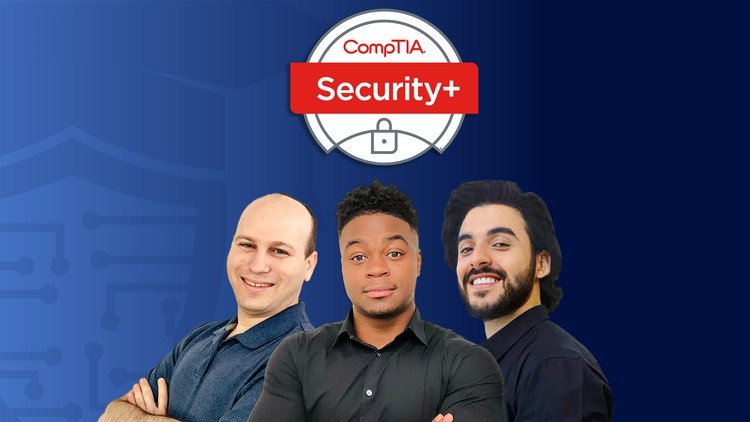CompTIA Security+ (SY0-701) Complete Course & Exam
- Description
- Curriculum
- FAQ
- Reviews

** Taught by a Best Selling IT Certification Instructor **
Taught by an expert in information technology and cybersecurity with over 20 years of experience, this course is a fun way to master the fundamentals of computer security.
You will learn the fundamentals of cybersecurity and gain experience in the configuration, management, and troubleshooting of common wired and wireless networks with lessons, lectures, and video demonstrations to teach you everything you need to know to pass the CompTIA Security+ exam.
CompTIA Security+ (SY0-701) is the world’s most popular cybersecurity certification today!
This course is designed to help prepare you for the CompTIA Security (SY0-701) certification exam and covers all the domains the Security+ (SY0-701) certification exam:
CompTIA Security+ (SY0-701):
-
General Security Concepts
-
Threats, Vulnerabilities, and Mitigations
-
Security Architecture
-
Security Operations
-
Security Program Management and Oversight
What You Will Receive In The Course:
-
Video lectures with the essential information needed to pass the Security+ (SY0-701) exam
-
A complete downloadable study guide in PDF format based on the lessons
-
Practice quizzes to ensure mastery of each section of the course
-
A full-length practice exam with multiple choice and mock simulations
This course stays current and up-to-date with the latest release of the CompTIA Security+ exam (SY0-701), and also provides a 30-day money-back guarantee if you are not satisfied with the quality of this course for any reason!
What Other Students Are Saying About My CompTIA Security+ Course:
-
Solid information, acronym break downs throughout the course (allows for better note taking). Jason is easy to follow, listen to, and understand during your study period (I sit for hours listening and taking notes and replaying the section) (Mark Guillen, 5 stars)
-
Just passed my security+ today! Dion’s course was excellent. It was all I needed, and I took his practice tests I also purchased. The only thing I think would help other testers is more sophisticated and harder performance-based questions as I experienced ones today that were pretty tough and required more hands-on experience. Overall, though completely worth the money. (Duran navarro, 5 stars)
-
The course is very informative and good for people that has no knowledge about cybersecurity so far. It teaches us about the harm caused by attacks and how to prevent them. I would suggest everyone to take this course, even if they don’t wan the certificate from Comptia. (Mahmoud Choumar, 5 stars)
-
Jason is a great pedagogue. He is thorough and amiable. The course has very minimal errors and you can tell he is very strict with the format of his lessons. I had very few questions during the lectures and only experience one issue throughout the whole experience. I will definitely buy more courses from him. I also bought the voucher from his website to get the retake for only 100 bucks! Good job Dion Training! Keep up the great job! (Victor Cabrales, 5 stars)
-
Passed the exam in December of 2022 using this course – FIRST TRY!! This course gave the back bone of everything I needed to pass the Sec. + exam. When the time came to study up a day or two before the actual exam, I used all the practice quizzes/tests from the CompTIA Sec. + study book. Seems thoughtless or stupid to not use the book for actual studying, but I found I learn slightly better in a class environment and this course/videos allowed me that. Thank you for this course and I look forward to many more in the future! Honestly, I haven’t taken an ACTUAL exam in years – many years. If I can do it, you all can too! Good luck and God speed! (Nathaniel Shumaker, 5 stars)
Upon completion of this course, you will earn 21 CEUs towards the renewal of your CompTIA A+, Network+, Security+, Linux+, Cloud+, PenTest+, CySA+, or CASP+ certifications.
-
5Fundamentals of Security
-
6Threats and Vulnerabilities
-
7Confidentiality (OBJ 1.2)
-
8Integrity (OBJ 1.2)
-
9Availability (OBJ 1.2)
-
10Non-repudiation (OBJ 1.2)
-
11Authentication (OBJ 1.2)
-
12Authorization (OBJ 1.2)
-
13Accounting (OBJ 1.2)
-
14Security Control Categories (OBJ 1.1)
-
15Security Control Types (OBJ 1.1)
-
16Gap Analysis (OBJ 1.2)
-
17Zero Trust (OBJ 1.2)
-
18Checkpoint: Fundamentals of Security
-
19Threat Actors (OBJ 1.2, 2.1, & 2.2)
-
20Threat Actor Motivations (OBJ 2.1)
-
21Threat Actor Attributes (OBJ 2.1)
-
22Unskilled Attackers (OBJ 2.1)
-
23Hacktivists (OBJ 2.1)
-
24Organized Crime (OBJ 2.1)
-
25Nation-state Actor (OBJ 2.1)
-
26Insider Threats (OBJ 2.1)
-
27Shadow IT (OBJ 2.1)
-
28Threat Vectors and Attack Surfaces (OBJ 2.2)
-
29Outsmarting Threat Actors (OBJ 1.2)
-
30Checkpoint: Threat Actors
-
31Physical Security (OBJ 1.2 & 2.4)
-
32Fencing and Bollards (OBJ 1.2)
-
33Attacking with Brute Force (OBJ 2.4)
-
34Surveillance Systems (OBJ 1.2)
-
35Bypassing Surveillance Systems (OBJ 2.4)
-
36Access Control Vestibules (OBJ 1.2)
-
37Door Locks (OBJ 1.2)
-
38Access Badge Cloning (OBJ 2.4)
-
39Checkpoint: Physical Security
-
40Social Engineering (OBJ 2.2 & 5.6)
-
41Motivational Triggers (OBJ 5.6)
-
42Impersonation (OBJ 2.2)
-
43Pretexting (OBJ 2.2)
-
44Phishing Attacks (OBJ 2.2)
-
45Preventing Phishing Attacks (OBJ 5.6)
-
46Conducting an Anti-Phishing Campaign (OBJ 5.6)
-
47Frauds and Scams (OBJ 2.2)
-
48Influence Campaigns (OBJ 2.2)
-
49Other Social Engineering Attacks (OBJ 2.2)
-
50Checkpoint: Social Engineering
-
51Malware (OBJ 2.4)
-
52Viruses (OBJ 2.4)
-
53Worms (OBJ 2.4)
-
54Trojans (OBJ 2.4)
-
55Viruses and Trojans (OBJ 2.4)
-
56Ransomware (OBJ 2.4)
-
57Zombies and Botnets (OBJ 2.4)
-
58Rootkits (OBJ 2.4)
-
59Backdoors and Logic Bombs (OBJ 2.4)
-
60Keylogger (OBJ 2.4)
-
61Spyware and Bloatware (OBJ 2.4)
-
62Malware Attack Techniques (OBJ 2.4)
-
63Indications of Malware Attacks (OBJ 2.4)
-
64Checkpoint: Malware
-
65Data Protection (OBJ 1.4, 3.3, 4.2, 4.4, & 5.1)
-
66Data Classifications (OBJ 3.3)
-
67Data Ownership (OBJ 4.2 & 5.1)
-
68Data States (OBJ 3.3)
-
69Data Types (OBJ 3.3 & 1.4)
-
70Data Sovereignty (OBJ 3.3)
-
71Securing Data (OBJ 3.3)
-
72Data Loss Prevention (DLP) (OBJ 4.4)
-
73Configuring a DLP (OBJ 4.5)
-
74Checkpoint: Data Protection
-
75Cryptographic Solutions (OBJ 1.4, 2.3, & 2.4)
-
76Symmetric vs Asymmetric (OBJ 1.4)
-
77Symmetric Algorithms (OBJ 1.4)
-
78Asymmetric Algorithms (OBJ 1.4)
-
79Hashing (OBJ 1.4)
-
80Increasing Hash Security (OBJ 1.4)
-
81Public Key Infrastructure (PKI) (OBJ 1.4)
-
82Digital Certificates (OBJ 1.4)
-
83Exploring Digital Certificates (OBJ 1.4)
-
84Blockchain (OBJ 1.4)
-
85Encryption Tools (OBJ 1.4)
-
86Obfuscation (OBJ 1.4)
-
87Cryptographic Attacks (OBJ 2.3 & 2.4)
-
88Checkpoint: Cryptographic Solutions








